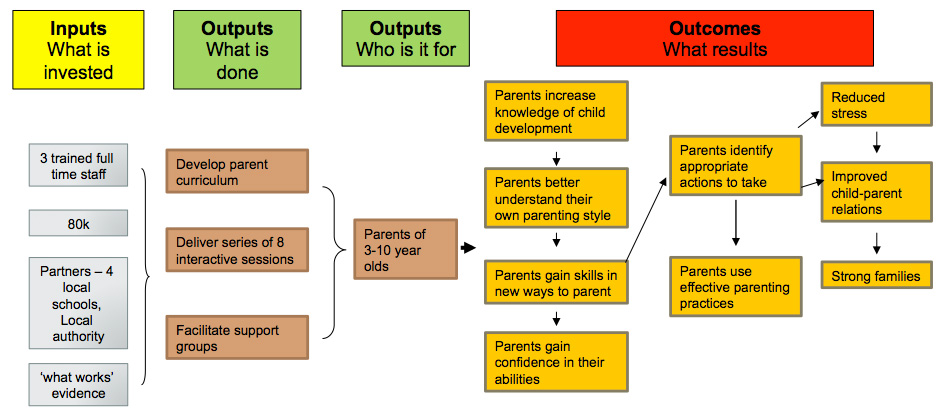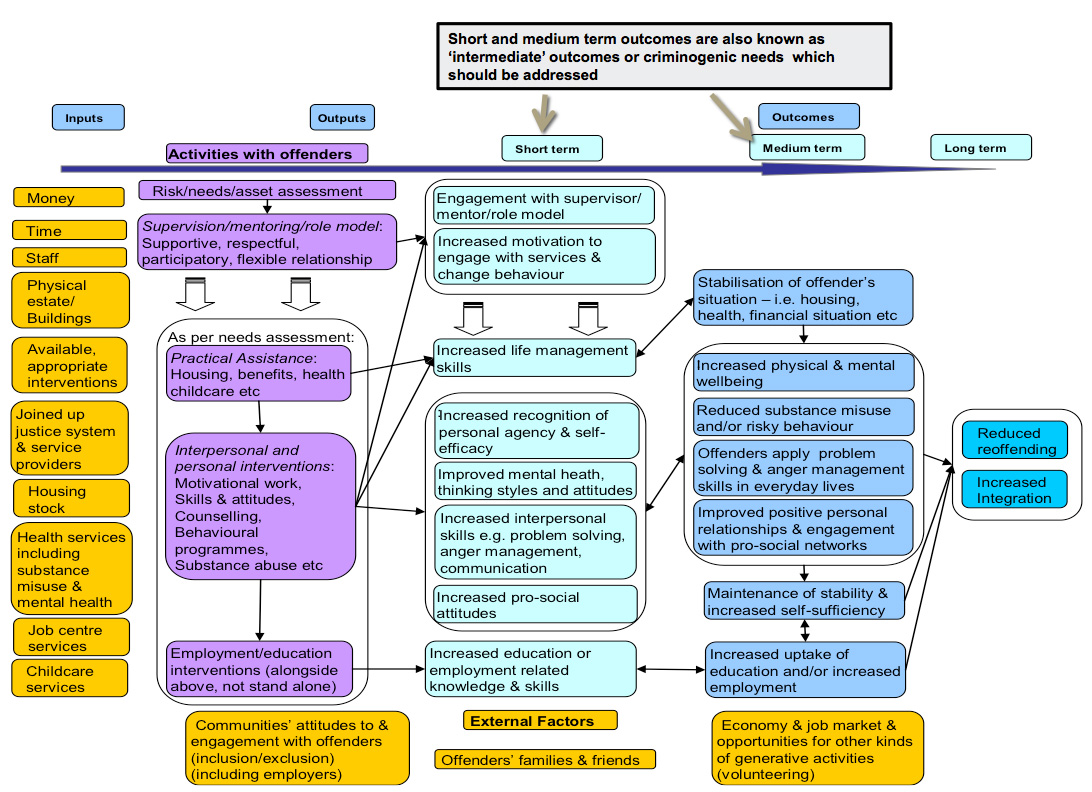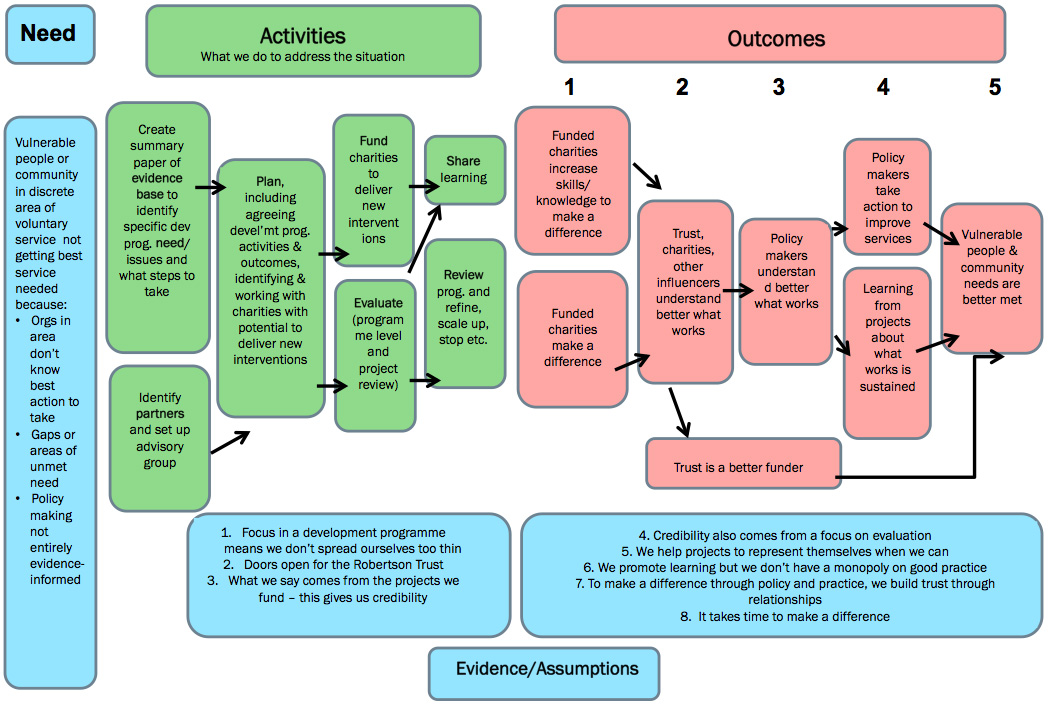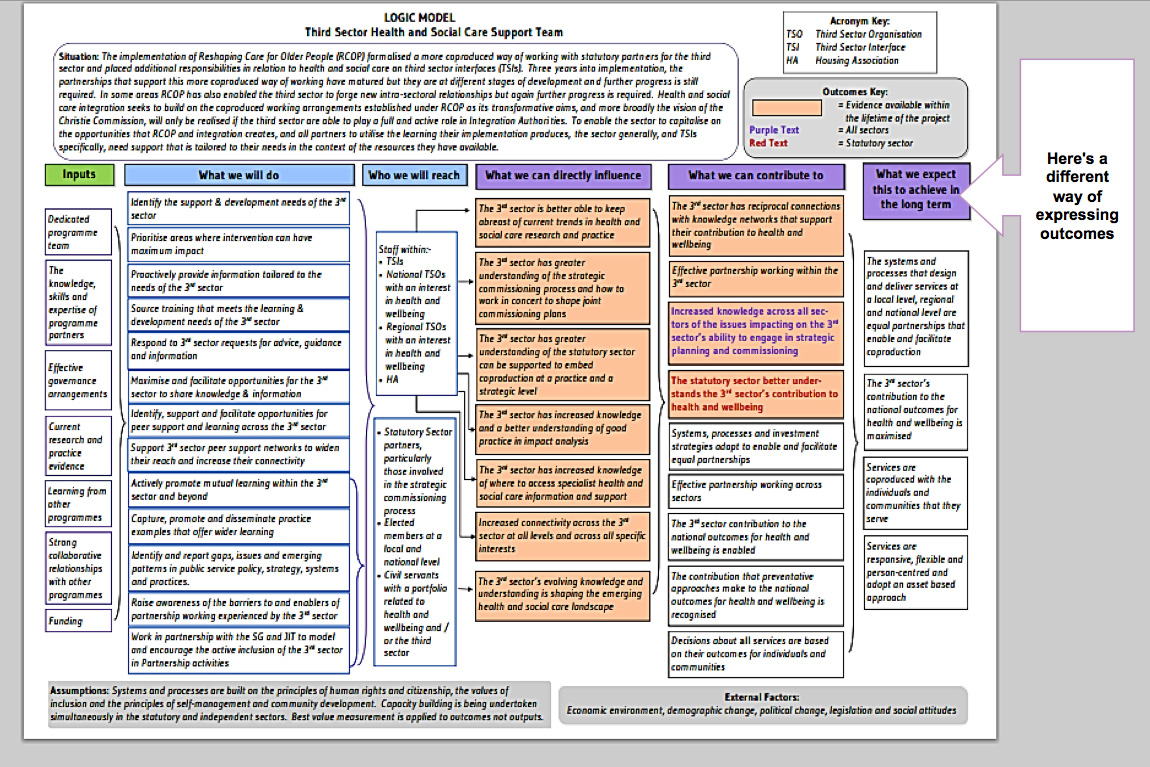The 5 Step Approach to Evaluation: Designing and Evaluating Interventions to Reduce Reoffending
Updated guidance on how to use the 5 Step approach to design and evaluate criminal justice interventions.
Step 3: Draw a logic model
Show how the project should work
Draw links between resources, activities and outcomes
What are logic models and who can use them?
What are logic models?
Logic models are step-by-step diagrams which simply show:
- What you're hoping to achieve in the long run (long-term outcomes)
- The process (short and medium term outcomes) through which your planned activities can be expected to lead to long-term aims.
- What resources will you need to do this (inputs)
Who can use them?
Anyone who is planning activities with particular aims in mind can benefit from using a logic model. This includes funders and commissioners, who might use them to plan how to assess applications and allocate funds in pursuit of their overall aims, as well as organisations and individuals planning behaviour change projects or services. A logic model is also used as the framework for collecting data and evaluating your service.
A very simple evidence-based model
Situation: I have a pounding headache

A more complex logic model
Situation: A recent parent survey in primary schools showed that 76% of parents of 3-10 year olds had struggled with dealing with tantrums in the last year. 59% of those parents said they felt 'stressed'.

Source: University of Wisconsin
What logic models can do
- Planning: Linking policies or projects to outcomes, or outcomes to policies
- Co-production and partnership working: Developing a logic model with partners clarifies roles and responsibilities and a shared understanding around outcomes
- Transparency and cohesion: Clear line of sight between activities and intended outcomes for external and internal audiences
- Monitoring and Performance management: Checking progress and links
- Evaluation: It's a tool for identifying process and outcome measures and then collect data to see if outcomes were achieved as defined in the model.
- Accountability: Identify outcomes that your project has direct control and influence over and complex
The logic model template

This blank template can be found here:
http://www.uwex.edu/ces/pdande/evaluation/evallogicmodel.html
Logic model column content - a quick guide
| Situation/Priorities: | What is the existing need/problem you are aiming to address? |
|---|---|
| Input: | What you need to invest (money, what evidence was embedded, materials, equipment, venue, technology, partners) |
| Activities: | What you do (e.g. conduct workshops, meetings, sessions, develop resources, assess, facilitate, provide one to-one support) |
| Participation: | Who you reach (e.g. users, clients, agencies, decision-makers, customers) |
| Short term outcomes: | What change happened in the short term? (e.g. awareness, learning, knowledge, skills, attitudes, motivations, aspirations, opinions) |
| Medium term outcomes: | What change happened in the medium term - ACTION (e.g. Practice and demonstrate new skills, behaviour, decision-making, policy change, social action) |
| Long term outcomes: | What is the ultimate outcome? (e.g. social change, economic change) |
| Assumptions: | (Linked to your review of the evidence) what assumptions need to be true in order for your model to work? |
| External factors: | What other factors will influence whether or not your outcomes are achieved? (e.g. economic conditions, local facilities, family context) |
Design a well structured intervention
Evaluating any intervention will be extremely difficult unless the intervention itself is run in a structured way, is focussed on outcomes and delivers clearly defined activities that should achieve those outcomes.
A well designed intervention has the following key features,
- Evidence-based activities, ways of working with users and outcomes.
- A clear understanding of the people they are targeting and why.
- Knowledge of how many people are eligible for the intervention , a record of user profiles , how many participate and how many complete and drop out.
- Staff with a shared understanding of the objectives and outcomes they want to achieve (e.g. what needs are being addressed).
- A record of costs and how the money is spent.
- A clear understanding of the skills the practitioners need and staff that have the right skills.
- Enough staff to make progress towards achieving outcomes .
- Structured activities that clearly are designed to improve outcomes based on what the evidence says should work.
- A resource-savvy evaluation plan that focuses on 3-4 priority evaluation questions based on what is most important to know, what is feasible to measure and on finding areas for improvement.
- Data collected on inputs (e.g. costs, staff numbers) , outputs (e.g. activities, participation) and priority outcomes (e.g. before and after scores).
TIP! All applicants for funding should be asked to demonstrate each of these features
A evidence-based logic model - Reducing Reoffending
The following logic model was generated from International evidence on 'what works' to reduce reoffending. It shows clear links between 'what you do' and the expected outcomes, based on what research studies tells us. It draws on the collective results from robust published evaluations and research, not on anecdotes or standalone studies.
This model is quite general, so interventions should be a bit more detailed about the evidence they have used to design and deliver the intervention and also describe the content of activities in more detail.
The Reducing Reoffending Evidence Model

A project logic model - A simple supervised bail logic model
The following simple logic model shows how a project aimed at improving family relationships for people on bail, improve employability and reduce reoffending is expected to work. It is based on international evidence about 'what works' to reduce reoffending and on research which highlights the importance of promoting positive relationships between workers and service users. It shows clear links between activities and the expected outcomes, based on what research studies tells us.
This model is quite general so service providers should be a bit more detailed about the evidence they have used to design and deliver the intervention and also describe the content of activities in more detail.
More examples of logic models can be found in 'The 5-step Approach to Evaluation: Designing and Evaluating Behaviour Change Interventions'.
A simple supervised bail logic model
| Inputs |
Outputs |
Outcomes |
|||
|---|---|---|---|---|---|
| Activities |
Participation |
Short‑term |
Medium‑term |
Long‑term |
|
| Bail workers (criminal justice social work/ third sector) Bail offices Time Money Partners: Evidence (support) |
Suitable candidates for SB identified and given SB Bail workers meet with bailees 2-4 times per week for an hour Bail workers assess bailee needs and signpost where appropriate |
Bailees and potential bailees |
Bailees feel they get on well with bail workers Bailees feel motivated to attend meetings and comply with conditions Bailees feel motivated to take up signposted services Bailees attitudes to their behaviour and aspirations change |
Bailees attend meetings Bailees comply with conditions Bailees engage with signposted services Bailees change behaviour and aspirations Compliance leads to community sentence Bailees stay in the community and out of prison |
Enhanced bailee relationships with family Reduced reoffending by bailees Enhanced employability |
A high level funding model
Logic models can be a valuable tool at every stage of planning and delivery of projects and services.
The next logic model shows an example of how they can be used by funders to plan their activities. This example is a generic framework developed by the Robertson Trust.

Using your logic model to show contribution and accountability for outcomes
The next page shows a real logic model from the Third Sector Health and Social Care team which clearly describes the outcomes they can directly influence, what they contribute to and what they can expect to achieve in the longer term.
The orange colour coding also shows which outcomes they could expect to achieve in the lifetime of the project.
TIP! Labelling outcomes in this way is a good way of communicating to funders what your project can and can't influence over the lifetime of your project. This will help to manage expectations and guide data collection from the outset.
Health and Social Care logic model - contribution

Contact
There is a problem
Thanks for your feedback